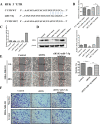Downregulation of exosomal miR-7-5p promotes breast cancer migration and invasion by targeting RYK and participating in the atypical WNT signalling pathway
- PMID: 36210461
- PMCID: PMC9549651
- DOI: 10.1186/s11658-022-00393-x
Downregulation of exosomal miR-7-5p promotes breast cancer migration and invasion by targeting RYK and participating in the atypical WNT signalling pathway
Abstract
Background: Current studies show that exosomal miRNAs become an important factor in cancer metastasis. Among the many miRNA studies, miR-7-5p has not been thoroughly investigated in breast cancer metastasis.
Methods: Bioinformatic screening was performed using extant data from the GEO database, and miR-7-5p expression levels in breast cancer cell lines and exosomes were further examined using real-time quantitative PCR (qRT-PCR). The extracted exosomes were characterised by transmission electron microscopy (TEM), particle size analysis and marker protein determination. Cell migration and invasion were then examined using wound healing assays and Transwell assays, respectively. Correlation between miR-7-5p and receptor-like tyrosine kinase (RYK) was analysed by luciferase reporter. The effect of miR-7-5p against RYK-related downstream factors was verified using western blot assays.
Results: In this study, we found that the expression of miR-7-5p was significantly different in exosomes secreted from breast cancer cell lines with different high and low invasiveness. Further experiments revealed that miR-7-5p has an important role in inhibiting the migration and invasion of breast cancer. In terms of mechanism of action, miR-7-5p was found to target the RYK, leading to its reduced expression, which in turn caused a reduction in the phosphorylation level of the downstream factor JNK. Reduced levels of phosphorylated JNK factors lead to reduced levels of phosphorylation of c-Jun protein, which in turn leads to increased expression of EMT transcription factors, thereby inhibiting the epithelial-mesenchymal transition (EMT) process to suppress the invasion of breast cancer.
Conclusion: Thus, we demonstrated that exosomes loaded with high levels of miR-7-5p emitted from less aggressive breast cancers can participate in the atypical WNT pathway by targeting the RYK gene and thus inhibit breast cancer metastasis.
Keywords: Atypical WNT pathway; Breast cancer; EMT; Exosome; RYK; miR-7-5p.
© 2022. The Author(s).
Conflict of interest statement
The authors declare that they have no competing interests.
Figures





Similar articles
-
Exosomal miR-18a-5p promotes EMT and metastasis of NPC cells via targeting BTG3 and activating the Wnt/β-catenin signaling pathway.Cell Cycle. 2023 Jul;22(13):1544-1562. doi: 10.1080/15384101.2023.2216508. Epub 2023 Jun 7. Cell Cycle. 2023. PMID: 37287276 Free PMC article.
-
MicroRNA-590-5p functions as a tumor suppressor in breast cancer conferring inhibitory effects on cell migration, invasion, and epithelial-mesenchymal transition by downregulating the Wnt-β-catenin signaling pathway.J Cell Physiol. 2019 Feb;234(2):1827-1841. doi: 10.1002/jcp.27056. Epub 2018 Sep 7. J Cell Physiol. 2019. Retraction in: J Cell Physiol. 2022 Mar;237(3):2003. doi: 10.1002/jcp.30515. PMID: 30191949 Retracted.
-
Exosomal miR-1255b-5p targets human telomerase reverse transcriptase in colorectal cancer cells to suppress epithelial-to-mesenchymal transition.Mol Oncol. 2020 Oct;14(10):2589-2608. doi: 10.1002/1878-0261.12765. Epub 2020 Aug 19. Mol Oncol. 2020. Retraction in: Mol Oncol. 2023 Jul;17(7):1454. doi: 10.1002/1878-0261.13452. PMID: 32679610 Free PMC article. Retracted.
-
Interplay between Wnt signaling molecules and exosomal miRNAs in breast cancer (Review).Oncol Rep. 2024 Aug;52(2):107. doi: 10.3892/or.2024.8766. Epub 2024 Jun 28. Oncol Rep. 2024. PMID: 38940326 Free PMC article. Review.
-
Mechanistic Features and Therapeutic Implications Related to the MiRNAs and Wnt Signaling Regulatory in Breast Cancer.Curr Mol Pharmacol. 2023;16(5):530-541. doi: 10.2174/1874467216666221017122105. Curr Mol Pharmacol. 2023. PMID: 36263474 Review.
Cited by
-
The role of non-coding RNAs in extracellular vesicles in breast cancer and their diagnostic implications.Oncogene. 2023 Oct;42(41):3017-3034. doi: 10.1038/s41388-023-02827-y. Epub 2023 Sep 5. Oncogene. 2023. PMID: 37670020 Free PMC article. Review.
-
The role of mir-7-5p in cancer: function, prognosis, diagnosis, and therapeutic implications.Mol Biol Rep. 2024 Nov 25;52(1):12. doi: 10.1007/s11033-024-10107-5. Mol Biol Rep. 2024. PMID: 39585455 Review.
-
Dynamic Role of Exosome microRNAs in Cancer Cell Signaling and Their Emerging Role as Noninvasive Biomarkers.Biology (Basel). 2023 May 12;12(5):710. doi: 10.3390/biology12050710. Biology (Basel). 2023. PMID: 37237523 Free PMC article. Review.
-
Blood-based liquid biopsy: insights into early detection, prediction, and treatment monitoring of bladder cancer.Cell Mol Biol Lett. 2023 Apr 4;28(1):28. doi: 10.1186/s11658-023-00442-z. Cell Mol Biol Lett. 2023. PMID: 37016296 Free PMC article. Review.
-
The impact of ferroptosis and ferroptosis-related non-coding RNAs on breast cancer progression.Front Cell Dev Biol. 2024 Dec 23;12:1506492. doi: 10.3389/fcell.2024.1506492. eCollection 2024. Front Cell Dev Biol. 2024. PMID: 39763590 Free PMC article. Review.
References
Publication types
MeSH terms
Substances
Grants and funding
LinkOut - more resources
Full Text Sources
Medical
Molecular Biology Databases
Research Materials
Miscellaneous

